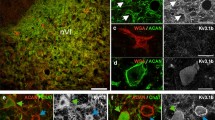Summary
Extracellular unit records were made from the left brain stem of decerebrate, paralysed giant toads (Bufo marinus) during passive movement of the ipsilateral eye. Units in the vestibular nuclear complex (VN) were identified by their short-latency responses to electrical stimulation of the anterior branch of the ipsilateral VIII cranial nerve.
Of 58 units in the region of VN, as judged from field potentials to VIII nerve stimulation, fourteen gave phasic excitatory responses to passive movement of the eye and were also identified as vestibular nuclear units. A further twelve units which responded to eye-movement could not be assigned to VN; the remaining 32 units were in VN but did not respond to passive eye-movement. Also, of 16 units whose recording sites were identified histologically in the VN complex, 11 gave responses to vestibular nerve stimulation and to passive eye-movement and 5 responded to eye-movement only.
Control experiments eliminated auditory, visual and cutaneous sources for the signal produced by passive eye-movement; thus, the signal must have arisen from intraorbital proprioceptors. Units in VN were also found which were excited by electrical stimulation of the intraorbital part of the fourth (trochlear) nerve; this provides strong evidence that proprioceptors in the extrinsic ocular muscles (EOM) are included in the receptors which provide the signal to VN during passive eye-movement.
The effects of vestibular stimulation and of passive eye-movement were found to interact upon units in VN. When passive eye-movement and vestibular stimulation were paired the response to the second stimulus was significantly reduced over a range of interstimulus intervals.
The conclusions are that orbital proprioceptive signals, including those from the EOM, project to the vestibular nuclei in the toad and, there, are able to influence processing of vestibular afferent signals. We suggest, therefore, that orbital proprioceptive signals may play a part in oculomotor control. The significance of the results is discussed in relation to the strategic position of the VN in the oculomotor control system.
Similar content being viewed by others
References
Allum J (1977) In: Baker R, Berthoz A (eds) Control of gaze by brain stem neurons. Elsevier/North-Holland Biomedical Press, Amsterdam New York
Ashton JA, Boddy A, Donaldson IML (1983a) Input from orbital proprioceptors to vestibular nuclear neurones in the giant toad Bufo Marinus. J Physiol (Lond) 334: 24–25P
Ashton JA, Boddy A, Donaldson IML (1983b) Stabilization of gaze after body tilt requires an optokinetic signal in the Giant Toad. J Physiol (Lond) Proceedings of September Meeting, 1983 in press
Buisseret-Delmas C (1976) Parcours trigeminal des fibres sensorielles provenant des muscles extrinseques de l'oeil chez le chat. Arch Ital Biol 114: 341–356
Carpenter RHS (1977) Movements of the Eyes. Pion, London
Chang HT, Wu CP (1959) Optic activation of cerebellar and vestibular neurons in the toad. Science Rev 3: 640–644
Dieringer N, Precht W (1982a) Compensatory head and eye movements in the frog and their contribution to stabilization of gaze. Exp Brain Res 47: 394–406
Dieringer N, Precht W (1982b) Dynamics of compensatory vestibular reflexes in the grassfrog, Rana temporaria. In: Roucoux A, Crommelinck M (eds) Physiological and pathological aspects of eye-movements. Dr. W. Junk Publishers, The Hague Boston London, pp 417–423
Dörrscheidt GJ (1981) The statistical significance of the peristimulus time histogram (PSTH). Brain Res 220: 397–401
Donaldson IML, Long AC (1980) Interactions between orbital proprioceptive and visual signals in the superior colliculus of the cat. J Physiol (Lond) 298: 85–110
Eden AR, Correia MJ, Steinkuller PG (1982) Medullary proprioceptive neurons from extraocular muscles in the pigeon identified with horseradish peroxidase. Brain Res 237: 15–21
Gernandt BE (1968) Interactions between extraocular myotatic and ascending vestibular activities. Exp Neurol 20: 120–134
Keller EL, Robinson DA (1971) Absence of a stretch reflex in extraocular muscle of the monkey. J Neurophysiol 34: 908–919
Maier A, De Santis M, Eldred E (1974) The occurrence of muscle spindles in extraocular muscles of various vertebrates. J Morphol 143: 397–408
Manni E, Palmieri G, Marini R (1971) Extraocular muscle proprioception and the descending trigeminal nucleus. Exp Neurol 33: 195–204
Matesz C (1981) Central projection of the VIII cranial nerve in the frog. Neuroscience 4: 2061–2071
Merrill EG, Ainsworth A (1972) Glass-coated platinum-plated tungsten microelectrodes. Med Biol Eng 10: 662–672
Precht W (1978) Neuronal operations in the vestibular system. Studies of brain function, vol 2. Springer, Berlin Heidelberg New York
Sabussow Von GH, Maslow AP, Burnaschewa DW (1964) Vergleichend-morphologische und einige histochemische Beobachtungen an besonderen Rezeptoren der Augenmuskeln bei Wirbeltieren. Anat Anz 114: S 27–37
Sherrington CS (1918) Observations on the sensual role of the proprioceptive nerve-supply of the extrinsic ocular muscles. Brain 41: 332–343
Whitteridge D (1955) A separate afferent nerve supply from the extraocular muscles of goats. Q J Exp Physiol 40: 331–336
Author information
Authors and Affiliations
Rights and permissions
About this article
Cite this article
Ashton, J.A., Boddy, A. & Donaldson, I.M.L. Input from proprioceptors in the extrinsic ocular muscles to the vestibular nuclei in the giant toad, Bufo marinus . Exp Brain Res 53, 409–419 (1984). https://doi.org/10.1007/BF00238171
Received:
Issue Date:
DOI: https://doi.org/10.1007/BF00238171




